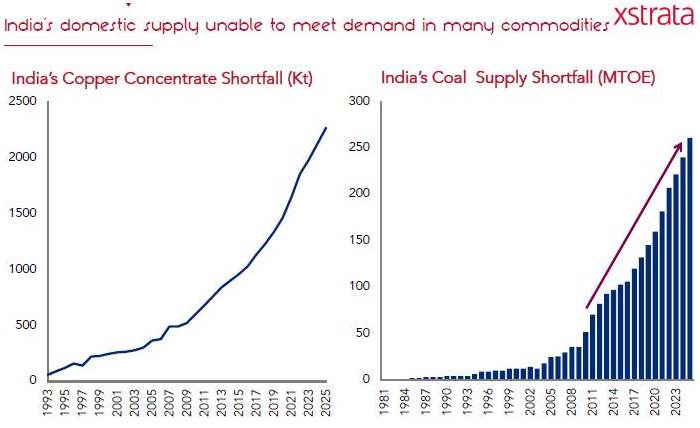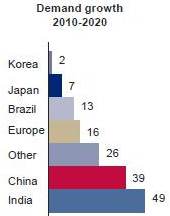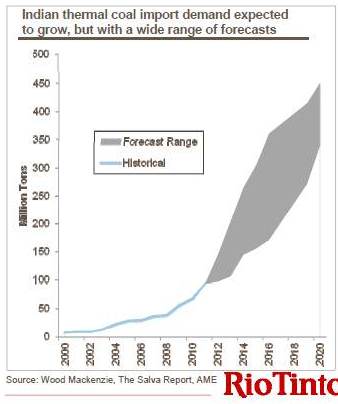China’s economy continues to produce a chorus of negative news—slowing earthmover sales, weak coal demand, and a broader acceptance by the leadership that the country appears to be moving onto a path of slower economic growth.
Accordingly, mining companies dependent on the Chinese market are looking for other regions to fill in the growing gap between the China-driven demand level they had planned for and what the market is actually yielding. The evolving content of mining company investor presentations suggests that an increasing number may be tweaking their earlier pure China emphasis and emphasizing India’s commodity demand more heavily than before as they look to other emerging markets to provide growth.
To understand how India is viewed within key boardrooms, we use the following proxy: we search for a given corporation’s initial mention in its investor presentations of India’s capacity to provide commodity demand growth—on a scale that implies it would be capable of at least partially compensating for a slowdown in the pace of Chinese demand for that commodity. This more specific definition helps screen out simple incidental mentions of India and focuses the inquiry on communications that more closely reflect managements’ prevailing view on the likely scale and growth rates of future Indian and Chinese commodity demand relative to one another.
Managements of major natural resource companies have long viewed India as a significant global commodity demand source. However, the shift reflected in the presentations is noteworthy because it suggests that India is no longer viewed as simply complementing Chinese commodity demand growth. Rather, it is being viewed as being large enough to substitute for lost Chinese demand as the Middle Kingdom’s growth slows down faster than many market participants anticipated.[1] It remains to be seen whether Indian commodity demand—especially for coal and copper—will be sufficient to help substantially offset the deficit resulting from China’s natural resource demand moving onto a slower growth trajectory sooner than expected.
Xstrata and Peabody Energy appear to be the front runners in treating India as a commodity marketing opportunity that would be large enough to drive demand growth in its own right and help compensate for a meaningful portion of lost demand from a slowing China. The companies first began to do so publicly in mid-2010, a time when competitors in the coal and copper markets were focused almost exclusively on China (Exhibit 1). Vale, an iron ore miner, made the shift in the third quarter of 2010 and the other companies’ presentations did not make pointed and specific mentions of India’s demand potential until the third quarter of 2011 and later.[2]
Exhibit 1: Corporate Presentations’ Initial Mention of India as Key Stand-alone Commodity demand driver

Source: Company reports
In 2012, corporate investor presentations have featured a flurry of slides reflecting a broader and deeper focus on India as the extent of lost Chinese demand becomes apparent, particularly in the coal, copper, and iron ore markets. Xstrata, for instance, forecasts that India’s need for imported copper concentrate will more than double between 2011 and 2021, requiring copper supply greater than 50% of that slated to be produced by the Oyu Tolgoi mine in Mongolia, which will be one of the world’s largest single copper mining operations when it comes fully online. Companies like Oyu Tolgoi’s operator
Rio Tinto
say China will remain the key global copper demand driver, but projections suggest that India will make substantial contributions to marginal demand growth due to rapid increases in copper demand as the country urbanizes and modernizes.
Exhibit 2: Indian copper and coal demand outlook

Source: Xstrata
India’s demand for seaborne metallurgical coal imports is also expected to exceed China’s between now and 2020 (Exhibit 3). A key driver for this is that India’s rising steel production cannot rely upon low quality domestic coking coal production and must import supplies instead.
India plans to invest
USD 1 trillion between 2012 and 2017 to revamp old infrastructure and local sources believe this could require as much as 250 million tonnes of steel. This, in turn, would require more than 190 million tonnes of coking coal atop what India already uses to feed its growing industrial sector.
Atop this, India’s per capita steel use is very low—only 59 kg per year as compared to 173 kg in Brazil and 466 kg in China, according to Peabody Energy. As such, there remains very significant upside for steel intensity to increase and drive further iron ore and coking coal demand. The country’s current robust demand and large future potential underpins a number of world-class coking coal projects, such as Vale’s Moatize mine in Mozambique.
Exhibit 3: Coking Coal Import Demand Growth Estimates

Source: Anglo American
India also has a rapidly rising need for imported thermal coal driven by increasing electricity demand and domestic coal production shortfalls. For instance, national coal monopoly
Coal India
only managed to boost coal production by 4 million tonnes (about 1%) between the 2011 and 2012 fiscal years. Such sluggish coal production growth sets the stage for major demand shortages and import needs, as India is preparing to add as much as 75 gigawatts of coal-fired power generation capacity in the next five years, which would require as much as 250 million additional tonnes of coal.
In light of this emerging thermal coal supply crunch, top global miners are assessing market opportunities. Rio Tinto, for instance, seeks to
enter the Indian thermal coal market
on a large scale and is looking at using Capesize bulk carriers to ship thermal coal from its fields in eastern Australia in order to meet demand increases that it believes could create thermal coal import needs of several hundred million tonnes per year (Exhibit 3).
Exhibit 4: India Thermal Coal Import Demand Outlook

Source: Rio Tinto
Implications
Indian demand for commodities such as copper, iron ore, and coal is likely to grow substantially in coming years as the country struggles to modernize its infrastructure and fight against power shortages by beefing up its electricity transmission system. The political motivations are strong, for in late July 2012, a
massive power outage
plunged 680 million people into darkness in 18 Indian states. Yet because Indian politicial decision making regarding large investment projects and reforms to legal regimes governing private business activity can be chaotic, the demand for the commodities is likely to be “lumpy” and feature more fits and starts than the steadier “ramp” trajectory growth that China delivered during its boom period.
Commodity investors and strategic planners should also bear in mind that while combined Chinese and Indian demand growth for key bulk commodities is likely to remain substantial in coming years, China is very likely headed onto a path of slower growth and India by itself will not be able to entirely supplant the lost demand that results from China’s slowing growth rates. India will to some extent offset the effects of China entering the slower growth part of its
S-curve trajectory
as China grapples with chronic health problems, inflation, pollution, and other headwinds. However, India will not be able to arrest the trend and the ongoing global pullback and postponement of many hard rock mining investments will not end at the hands of Indian growth alone.
[1] We exclude potash producers from the analysis because India has been a key driver of global potash demand for many years, thereby predating the China-driven commodity boom.
[2] Companies whose materials we reviewed included those shown in Exhibit 1, as well as Rusal, Norilsk Nickel, Fortescue, Freeport McMoran, Codelco, and Alcoa.


